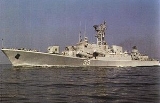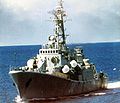
Kotor class frigate
Encyclopedia
The Kotor class is the name for an anti-submarine warfare
frigate
built by the SFR Yugoslavia. It was developed on the basis of the Soviet Koni class
, but with significant modifications and improvements. Two were built in the Tito shipyard at Kraljevica
and introduced to service in 1988, while two Yugoslav Koni class frigates (RF-31 Split and RF-32 Koper) were upgraded to the Kotor class in the 1985 and 1986. Kotor class frigates were used by SFR Yugoslav Navy (JRM) until the Yugoslav wars
, when in 1992 they were passed to the SFR's successor navy - FR Yugoslav Navy (RM VJ), known as the Serbia and Montenegro Navy (RM VSCG) since 2003. Both of Kotor class frigates remains with the Montenegro Navy
.
The frigates are armed with four missiles, ship-to-ship P-21 or P-22 (NATO code SS-N-2 Styx). The weight of the missiles is 2607 kg, warhead weighing 480 kg, with a range from 8 to 80 km altitude flying at 25 or 50 meters, at a speed of Mach 0.9. They have infra-red self-guidance systems (P-22) or active radar guidance (P-21).
For air defense, the ships use OSA-M missile systems (NATO code SA-N-4 Gecko). It consists of the radio-controlled guided anti-aircraft missile RZ-13 mounted on the double ejector type missile rail ZIF-122, device management and shooting training operator. The RZ-13 missile can effectively destroy targets that fly at a height of 50-6,000 m at a distance to 15 km.
The ship has two quadruple launchers MTU-IV with four air Strela 2M missiles. Launchers are compatible with other, more modern MANPADS.
Two rocket twelvebarelled depth charge launchers RBU-6000 are intended for anti-submarine warfare. Their range is 350 to 5,500 m, with a maximum target depth of 400 m.
The frigates are also armed with artillery, consisting of a universal automatic AK-726 cannon caliber 2x76.2 mm and two AK-230 caliber 30 mm cannons.
The Kotor frigates are equipped with sensors to detect and track targets. To detect surface and air targets, the MR-302 Rubka (NATO codename Strut Curve) radar is used, which has an approximately 110 km range, while the RM 1226 Decca radar is intended for navigation. The MPZ-301 (NATO code Pop Group) radar system is used to fire Osa-M missiles, and for the management of artillery fire observation and sighting radar systems operation 9LV-200 MK-2 and sighting radar MR-104 Ris are used. The ships also have active sonar, radiological detectors, laser detectors and detector for radar irradiate. For the defense of anti-ship missiles frigate is equipped with infrared laser and Barricade type radar decoys.
The Kotors are powered by CODAGE (combined), consisting of one M8G gas turbine, providing a maximum power of 14,720 kW and two Pielstick SEMT 12 PA 6V diesel engines, providing power of 280 kW by 3648. The ship has three propellers - two for diesel engines and one for the gas turbine. The main drive represents diesel engines and are used most of the time, while the gas turbine was designed to provide additional speed during the performance of combat tasks.
The other ship systems include a device for degaussing of the ship, two desalinization devices for the production of drinking water, devices for radio link, the device to receive data from hydroacoustic buoys, devices for underwater connection, firefighting and drainage pumps, fuel pumps for the draft and oil, system air conditioning, fire system on the basis of halogen, equipment for the production of electricity and others.
Anti-submarine warfare
Anti-submarine warfare is a branch of naval warfare that uses surface warships, aircraft, or other submarines to find, track and deter, damage or destroy enemy submarines....
frigate
Frigate
A frigate is any of several types of warship, the term having been used for ships of various sizes and roles over the last few centuries.In the 17th century, the term was used for any warship built for speed and maneuverability, the description often used being "frigate-built"...
built by the SFR Yugoslavia. It was developed on the basis of the Soviet Koni class
Koni class frigate
Koni class is the NATO reporting name for a anti-submarine warfare frigate built by the Soviet Union. They were known in the Soviet Union as Project 1159. 14 were built in Zelenodolsk shipyard between 1975 and 1988. They were originally intended to replace the older Riga class frigates, but were...
, but with significant modifications and improvements. Two were built in the Tito shipyard at Kraljevica
Kraljevica
Kraljevica is a town in the Kvarner region of the country of Croatia, located between Rijeka and Crikvenica, approximately thirty kilometers from Opatija and near the entrance to the bridge to the island of Krk...
and introduced to service in 1988, while two Yugoslav Koni class frigates (RF-31 Split and RF-32 Koper) were upgraded to the Kotor class in the 1985 and 1986. Kotor class frigates were used by SFR Yugoslav Navy (JRM) until the Yugoslav wars
Yugoslav wars
The Yugoslav Wars were a series of wars, fought throughout the former Yugoslavia between 1991 and 1995. The wars were complex: characterized by bitter ethnic conflicts among the peoples of the former Yugoslavia, mostly between Serbs on the one side and Croats and Bosniaks on the other; but also...
, when in 1992 they were passed to the SFR's successor navy - FR Yugoslav Navy (RM VJ), known as the Serbia and Montenegro Navy (RM VSCG) since 2003. Both of Kotor class frigates remains with the Montenegro Navy
Montenegrin Navy
The Montenegrin Navy is a branch of the Military of Montenegro.-Naval Base:*Command Station*Patrol Boat Unit*Coastal Reconnaissance and Guidance Unit*Search and Rescue Unit*"Jadran" Training Center...
.
Design
The hull used sheet steel with a thickness of 3 to 15 mm, while the superstructure is made of aluminum alloy with a thickness of 2 to 10 mm. The superstructure was designed to reduce radar reflection.The frigates are armed with four missiles, ship-to-ship P-21 or P-22 (NATO code SS-N-2 Styx). The weight of the missiles is 2607 kg, warhead weighing 480 kg, with a range from 8 to 80 km altitude flying at 25 or 50 meters, at a speed of Mach 0.9. They have infra-red self-guidance systems (P-22) or active radar guidance (P-21).
For air defense, the ships use OSA-M missile systems (NATO code SA-N-4 Gecko). It consists of the radio-controlled guided anti-aircraft missile RZ-13 mounted on the double ejector type missile rail ZIF-122, device management and shooting training operator. The RZ-13 missile can effectively destroy targets that fly at a height of 50-6,000 m at a distance to 15 km.
The ship has two quadruple launchers MTU-IV with four air Strela 2M missiles. Launchers are compatible with other, more modern MANPADS.
Two rocket twelvebarelled depth charge launchers RBU-6000 are intended for anti-submarine warfare. Their range is 350 to 5,500 m, with a maximum target depth of 400 m.
The frigates are also armed with artillery, consisting of a universal automatic AK-726 cannon caliber 2x76.2 mm and two AK-230 caliber 30 mm cannons.
The Kotor frigates are equipped with sensors to detect and track targets. To detect surface and air targets, the MR-302 Rubka (NATO codename Strut Curve) radar is used, which has an approximately 110 km range, while the RM 1226 Decca radar is intended for navigation. The MPZ-301 (NATO code Pop Group) radar system is used to fire Osa-M missiles, and for the management of artillery fire observation and sighting radar systems operation 9LV-200 MK-2 and sighting radar MR-104 Ris are used. The ships also have active sonar, radiological detectors, laser detectors and detector for radar irradiate. For the defense of anti-ship missiles frigate is equipped with infrared laser and Barricade type radar decoys.
The Kotors are powered by CODAGE (combined), consisting of one M8G gas turbine, providing a maximum power of 14,720 kW and two Pielstick SEMT 12 PA 6V diesel engines, providing power of 280 kW by 3648. The ship has three propellers - two for diesel engines and one for the gas turbine. The main drive represents diesel engines and are used most of the time, while the gas turbine was designed to provide additional speed during the performance of combat tasks.
The other ship systems include a device for degaussing of the ship, two desalinization devices for the production of drinking water, devices for radio link, the device to receive data from hydroacoustic buoys, devices for underwater connection, firefighting and drainage pumps, fuel pumps for the draft and oil, system air conditioning, fire system on the basis of halogen, equipment for the production of electricity and others.
Operators
- YugoslaviaYugoslaviaYugoslavia refers to three political entities that existed successively on the western part of the Balkans during most of the 20th century....
(SFRY and FRY) - 2 ships, Kotor (RF-33) and Pula (RF-34) (Novi Sad since 1992) - MontenegroMontenegroMontenegro Montenegrin: Crna Gora Црна Гора , meaning "Black Mountain") is a country located in Southeastern Europe. It has a coast on the Adriatic Sea to the south-west and is bordered by Croatia to the west, Bosnia and Herzegovina to the northwest, Serbia to the northeast and Albania to the...
- 2 ships, ex-Kotor (P-33) ex-Pula (P-34)
Ships
| Image | Ship | Builder | Launched | Completed | Fate |
|---|---|---|---|---|---|
 |
P-33 Kotor | Tito shipyard, Kraljevica Kraljevica Kraljevica is a town in the Kvarner region of the country of Croatia, located between Rijeka and Crikvenica, approximately thirty kilometers from Opatija and near the entrance to the bridge to the island of Krk... |
1985 | 29 December 1986 | in service, refurbished |
 |
P-34 Pula (Novi Sad since 1992) | Tito shipyard, Kraljevica Kraljevica Kraljevica is a town in the Kvarner region of the country of Croatia, located between Rijeka and Crikvenica, approximately thirty kilometers from Opatija and near the entrance to the bridge to the island of Krk... |
1986 | 25 February 1988 | in service, refurbished |

